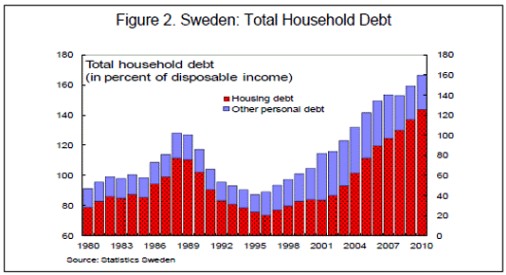
In an interesting development, The Swedish Bankers’ Association will reportedly ask banks to force households to pay down mortgages with loan-to-value ratios (LVRs) of above 70%. From Bloomberg:
“Many households do not build a necessary buffer for their mortgage and a more healthy credit culture needs to be created,” Thomas Oestros, head of the association, wrote.
Low rates over the past years and a limited housing supply have fueled a surge in home prices and pushed debt levels to records in the $550 billion economy. Officials are working on a set of rules that will span several years of regulation to get debt growth under control and lower financial risks. They have signaled they will present a plan in the spring…
A report released last year by the FSA showed that at the current pace of amortization it would take households on average 140 years to repay their loans. Only 40 percent of borrowers with mortgages smaller than 75 percent of their property’s value actually pay down their debt, the report showed.
Like many other developed nations, Sweden’s household debt has ballooned since the mid-1990s, reaching 163% in of personal disposable income in 2010. Mortgage debt has been the primary driver, increasing from 73% of disposable incomes in 1996 to 145% in 2010:

Traditionally, Sweden’s housing system has encouraged the build-up of household debt.
Access to mortgage credit has until recently been loose in Sweden. In the years leading up to the Global Financial Crisis (GFC), loans were typically granted up to 95% of property value, although 100% plus loans were also available. Loan amortisation periods are also particularly long in Sweden – at 100 years for houses and 200 years for tenant-owner apartments.
The Swedish tax system also encourages house purchases over other investment options. Owner occupiers are allowed to deduct 30% of mortgage interest from their marginal rate of tax. Although there is also a capital gains tax of 30% on two-thirds of any price rises, this can be deferred as long as another owner occupied property is bought, and the rule applies to heirs as well.
And like in Australia, Swedish authorities implemented a range of measures to stimulate the housing market and maintain the flow of mortgage credit during the onset of the GFC.
Tax breaks were implemented in 2008 for homeowners wishing to renovate newly purchased properties. The Government also stepped-up the provision of liquidity to the banking sector, guaranteeing the funding of the banks and mortgage institutions, as well as establishing a long-term stability fund to deal with any future solvency problems.
A wealth tax was also abolished in 2008 as was a national real estate tax, replaced by a lower municipal property fee, which helped to sustain demand for houses.
More recently, Swedish authorities have attempted to dampen demand by strengthening safeguards on excessive mortgage lending. In October 2010, Sweden’s financial regulator, the Financial Supervisory Authority (FSA), capped mortgage LVRs at 85%, a move that helped slow annual mortgage growth. Capital adequacy requirements on Swedish mortgage lenders were also tripled.
While Sweden is taking action on the demand-side of the housing market, the supply-side remains highly restrictive, resulting in homebuilding rates near the bottom of European countries.
According to the RICS 2011 European Housing Review:
Housing construction costs are the highest in Europe, according to Eurostat, at around 55% above the EU average. The OECD attributes high house building costs to market structures that evolved in the era of high housing subsidies, limited competition, low levels of construction imports, and heavy regulations – all of which constrain competition and innovation.
Supply responsiveness is affected by land supply constraints. Land shortages occur for NIMBY reasons. Complex and lengthy processes of plan formulation and then appeals procedures generate considerable delay even where residential development is permitted. Furthermore, the structure of local authority finance discourages new development. Until the 2008 reforms, no local taxation was derived from property and municipalities still have large upfront costs, with little prospect of payback for many years to come, so the incentives still do not seem that positive…
Owner occupation has become the sole option for housing aspirations of many in a situation of constrained supply. This has encouraged a long trend of higher prices, which have generated wealth gains for some…
It will be interesting to watch whether Sweden has much success reigning-in household debt and mortgage credit. Without supply-side reform, shortages are likely to remain, causing intense competition between Swedes for the limited stock of housing, along with upward pressure on home prices.

